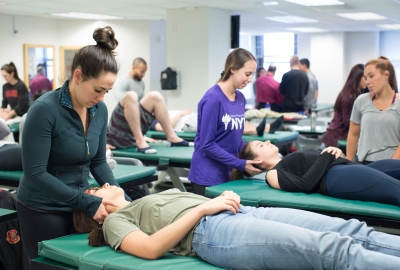
The DPT curriculum for the Practicing Physical Therapist consists of 36 credits, which may be taken on a full or part-time basis. In addition to being part of the largest private university in the world with its multiplicity of offerings, services, libraries, outstanding faculty and facilities, and state of the art sports and exercise facilities, here are 10 reasons why New York University should be your choice for a post-professional Doctor of Physical Therapy degree.
1. OPPORTUNITY TO ACHIEVE COMPETENCE IN ALL ASPECTS OF PHYSICAL THERAPY PRACTICE. Students can fill gaps in their current knowledge and skills in order to achieve full competence for all types of clinical practice and for fitness and wellness programs. Students can upgrade their knowledge and skills to provide competent physical therapy services to patients or clients with functional limitations from conditions or impairments in the cardiopulmonary, musculoskeletal, neuromuscular and other systems, including the reproductive, integumentary and genitourinary. For each of these systems, courses are available in pathology, pharmacology, radiology, physical therapy examination, and physical therapy interventions. Students also take courses that prepare them to conduct evidence-based practice and to work in wellness and fitness programs.
2. OPPORTUNITY TO DEVELOP SKILLS FOR A UNIQUE PRACTICE IN WOMEN’S HEALTH OR WOUND CARE. NYU offers training in state-of-the-art techniques for physical therapy examinations and interventions in women’s health, including incontinence and reproductive health; and in wound care, including ulcers and burn care. Update your knowledge and skills, or develop new ones to expand your physical therapy practice.
3. CONTENT BASED ON PROFESSIONAL STANDARDS. The curriculum is based upon the APTA documents Normative Model of Professional Physical Therapy Education and Guide to Physical Therapist Practice. The Guide clearly defines physical therapist practice based upon the model of examination, evaluation, diagnosis, prognosis, intervention, and determination of outcomes. The program is also predicated upon the preparation of physical therapy professionals who are competent generalist practitioners and is based on the mission of the PT Program.
4. NO CAPSTONE PROJECT/RESEARCH THESIS REQUIRED. Our DPT program’s aim is to educate professional doctoral physical therapists who are knowledgeable, self-assured, adaptable, reflective, humanistic, and service-oriented, and who by virtue of critical thinking, life-long learning, and ethical values, render independent judgments concerning patient/client needs. While our students are well-rounded and knowledgeable in physical therapy literature and evidence, as opposed to developing researchers, the DPT program aspires to develop the most skilled, exemplary practitioners possible. If research is your ultimate goal, please see our internationally renowned, post-professional PhD program.
5. ADDITIONAL CERTIFICATIONS. Students have the opportunity to obtain several certifications designed to enhance their potential practices. These include Pilates beginner mat, and the National Strength and Conditioning Association’s Specialist Certification.
6. SPECIAL ACCOMMODATIONS FOR THE WORKING STUDENT. We recognize that part-time students in the program may occasionally miss classes due to commitments related to work or other professional activities. Specific classes may be video-taped so that students have full access to all of the information provided.
7. SMALL CLASS SIZE. The number of students in the classes varies from 24 to 30, thus providing a more personalized learning experience for students.
8. FACULTY-STUDENT RATIO. The full-time faculty student-ratio is one faculty member to nine students, a most impressive ratio. And that does not even consider the over forty-five adjunct faculty members whose background knowledge and skill are essential for our in-depth curriculum.
9. UNIQUE INSTRUCTIONAL METHODS. The faculty also determined that no single instructional method would be used throughout the curriculum. Rather, a variety of instructional methods are utilized based on the content of a particular instructional unit and the desired outcomes of the unit. The curriculum includes a combination of subject matter-based learning in didactic areas, competency-based learning in didactic and clinical aspects of the physical therapy examinations and interventions, and problem-solving-based in the system-related intervention arenas. Evidence-based practice is emphasized throughout the curriculum.
10. LEADER IN PHYSICAL THERAPY EDUCATION. Please see our detailed Department history. Since our inception in 1927, we have led the way in physical therapy education. Our faculty consists of visionary leaders in the profession who in addition to being renowned authors and researchers, have held such significant positions as President of the American Physical Therapy Association (APTA) and Editor of Physical Therapy, the Journal of the APTA. With the knowledge and experience they have amassed here at NYU, graduates of our Program have gone on to successful and prestigious careers. Read about our outstanding alumni here.
